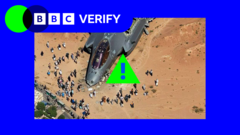Recent events have triggered a wave of misleading content online, with AI tools being used to create false narratives and images that muddy the waters of the current conflict.
**Navigating the Tide of AI-Driven Disinformation in the Israel-Iran Conflict**

**Navigating the Tide of AI-Driven Disinformation in the Israel-Iran Conflict**
A surge in artificial intelligence-generated disinformation emerges alongside escalating military tensions between Israel and Iran.
The use of sophisticated AI in producing disinformation highlights a new age of information warfare where digital manipulation complicates truth and accountability.
In this tumultuous period of military engagement, the digital landscape has become overrun by a deluge of misinformation, primarily fueled by AI technology. Analysis reveals that since Israel intensified its operations against Iran last week, dozens of posts have circulated online aimed at amplifying disinformation regarding both nations' military capabilities. BBC Verify's findings indicate that several fabricated videos, emphasizing Iran’s military prowess and the aftermath of purported Israeli strikes, have collectively attracted over 100 million views across various platforms.
The volume of misleading content has grown remarkably, with pro-Israel accounts also disseminating disinformation by sharing outdated protest footage from Iran, falsely arguing that it reflects increasing public dissent against the Iranian government and support for Israel’s military initiatives. The Israeli airstrikes initiated on June 13 have provoked a series of Iranian missile retaliations; however, what’s alarming is the unprecedented scale of AI-generated misinformation emerging in response to the situations on the ground.
One organization specializing in open-source intelligence recently stated that this represents “the first time we’ve witnessed generative AI utilized extensively during a conflict.” Geoconfirmed, a verification group, highlighted the troubling trend of users, described as “engagement farmers,” who profit from the chaos by spreading misleading and sensationalist footage online. Their claims include the use of recycled content from unrelated incidents and previously recorded conflicts, with some clips reportedly racking up millions of views.
Notably, certain accounts have emerged as “super-spreaders” of misinformation, with a remarkable surge in followers. A pro-Iranian account named Daily Iran Military skyrocketed from around 700,000 followers post-strikes to 1.4 million within just a week, showcasing how easily disinformation can saturate social media platforms.
Further complicating matters, AI-generated images exaggerated Iran's military responses, including a strikingly popular video depicting missiles launched against Tel Aviv, illustrating the conflicting narratives being pushed to capture attention. Additional clips falsely showcased missile strikes on Israeli infrastructure and portrayed the purported destruction of advanced F-35 fighter jets, with an expert noting the inaccuracies pointed to AI alterations in the content.
As conflicting narratives spread, claims of Iranian F-35 victories have come under scrutiny. One particular video suggested an Israeli aircraft had been shot down, only for investigations to reveal it hailed from a flight simulator game. TikTok, responding to the outcry, removed the misleading footage after being alerted by BBC Verify.
Misinformation has also found traction with some major social media users with histories of posting on various conflicts. Experts speculate that some of these individuals might be monetizing the influx of views that conflict-related content generates. In stark contrast, many pro-Israel narratives have suggested a crisis of dissent within Iranian society, characterized by AI-generated content depicting fictitious public support for Israel among Iranians.
As the uncertainty in the region leads to heightened tensions, some accounts began circulating AI-generated images depicting US B-2 bombers over Iranian cities, feeding into established narratives about potential US military action in response to the rising conflict.
Social media platforms, primarily using X (formerly Twitter), have seen a spike in disinformation. Users frequently turn to the platform's AI chatbot, Grok, to verify content. However, there have been instances where Grok misidentified obvious AI-manipulated videos as legitimate. X’s lack of a response regarding their AI bot’s inaccuracies leaves room for concern about the efficacy and responsibility in combating disinformation.
While TikTok assures efforts to manage and eliminate false narratives on its platform, Instagram’s parent company Meta did not respond to inquiries regarding its stance on the matter. The motivations behind sharing disinformation reflect broader societal tendencies where emotionally charged and sensational content tends to spread rapidly, amplifying the overall degree of confusion during conflicts like this one.
As the aftermath of the conflict continues to unfold, the need for diligent fact-checking and transparent information dissemination stands paramount to combatting misinformation's tide in the digital age.
In this tumultuous period of military engagement, the digital landscape has become overrun by a deluge of misinformation, primarily fueled by AI technology. Analysis reveals that since Israel intensified its operations against Iran last week, dozens of posts have circulated online aimed at amplifying disinformation regarding both nations' military capabilities. BBC Verify's findings indicate that several fabricated videos, emphasizing Iran’s military prowess and the aftermath of purported Israeli strikes, have collectively attracted over 100 million views across various platforms.
The volume of misleading content has grown remarkably, with pro-Israel accounts also disseminating disinformation by sharing outdated protest footage from Iran, falsely arguing that it reflects increasing public dissent against the Iranian government and support for Israel’s military initiatives. The Israeli airstrikes initiated on June 13 have provoked a series of Iranian missile retaliations; however, what’s alarming is the unprecedented scale of AI-generated misinformation emerging in response to the situations on the ground.
One organization specializing in open-source intelligence recently stated that this represents “the first time we’ve witnessed generative AI utilized extensively during a conflict.” Geoconfirmed, a verification group, highlighted the troubling trend of users, described as “engagement farmers,” who profit from the chaos by spreading misleading and sensationalist footage online. Their claims include the use of recycled content from unrelated incidents and previously recorded conflicts, with some clips reportedly racking up millions of views.
Notably, certain accounts have emerged as “super-spreaders” of misinformation, with a remarkable surge in followers. A pro-Iranian account named Daily Iran Military skyrocketed from around 700,000 followers post-strikes to 1.4 million within just a week, showcasing how easily disinformation can saturate social media platforms.
Further complicating matters, AI-generated images exaggerated Iran's military responses, including a strikingly popular video depicting missiles launched against Tel Aviv, illustrating the conflicting narratives being pushed to capture attention. Additional clips falsely showcased missile strikes on Israeli infrastructure and portrayed the purported destruction of advanced F-35 fighter jets, with an expert noting the inaccuracies pointed to AI alterations in the content.
As conflicting narratives spread, claims of Iranian F-35 victories have come under scrutiny. One particular video suggested an Israeli aircraft had been shot down, only for investigations to reveal it hailed from a flight simulator game. TikTok, responding to the outcry, removed the misleading footage after being alerted by BBC Verify.
Misinformation has also found traction with some major social media users with histories of posting on various conflicts. Experts speculate that some of these individuals might be monetizing the influx of views that conflict-related content generates. In stark contrast, many pro-Israel narratives have suggested a crisis of dissent within Iranian society, characterized by AI-generated content depicting fictitious public support for Israel among Iranians.
As the uncertainty in the region leads to heightened tensions, some accounts began circulating AI-generated images depicting US B-2 bombers over Iranian cities, feeding into established narratives about potential US military action in response to the rising conflict.
Social media platforms, primarily using X (formerly Twitter), have seen a spike in disinformation. Users frequently turn to the platform's AI chatbot, Grok, to verify content. However, there have been instances where Grok misidentified obvious AI-manipulated videos as legitimate. X’s lack of a response regarding their AI bot’s inaccuracies leaves room for concern about the efficacy and responsibility in combating disinformation.
While TikTok assures efforts to manage and eliminate false narratives on its platform, Instagram’s parent company Meta did not respond to inquiries regarding its stance on the matter. The motivations behind sharing disinformation reflect broader societal tendencies where emotionally charged and sensational content tends to spread rapidly, amplifying the overall degree of confusion during conflicts like this one.
As the aftermath of the conflict continues to unfold, the need for diligent fact-checking and transparent information dissemination stands paramount to combatting misinformation's tide in the digital age.





















